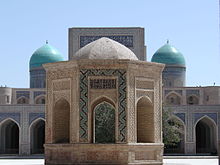| This article needs additional citations for verification. Please help improve this article by adding citations to reliable sources. Unsourced material may be challenged and removed. Find sources: "Shadirvan" – news · newspapers · books · scholar · JSTOR (July 2021) (Learn how and when to remove this message) |


A shadirvan (Persian: شادروان, Turkish: şadırvan, Arabic: شاذروان) is a type of fountain that is usually built in the courtyard or near the entrance of mosques, caravanserais, khanqahs, and madrasas, with the main purpose of providing water for drinking or ritual ablutions to several people at the same time, but also as decorative visual or sound elements.
Shadirvans are Persian in origin and, with a curtain or drape, were originally placed in the tents of rulers or on the balconies of palaces. They are a typical element of Ottoman architecture.
See also
- Cantharus, a similar fountain in Christian places of worship
- Howz
- Sebil or sabil, public water fountain in Islamic countries
References
- Rabbat, Nasser (1960–2007). Bearman, P.; Bianquis, Th.; Bosworth, C.E.; van Donzel, E.; Heinrichs, W.P. (eds.). Encyclopaedia of Islam, Second Edition. Brill. ISBN 9789004161214.
- Sumner-Boyd, Hilary; Freely, John (2010). Strolling Through Istanbul: The Classic Guide to the City (Revised ed.). Tauris Parke Paperbacks.
- Goodwin, Godfrey (1971). A History of Ottoman Architecture. New York: Thames & Hudson. ISBN 0500274290.
External links
[REDACTED] Media related to Şadırvans at Wikimedia Commons
| Islamic architecture | ||||||||||||||||||||
|---|---|---|---|---|---|---|---|---|---|---|---|---|---|---|---|---|---|---|---|---|
| Styles | ||||||||||||||||||||
| Elements |
| |||||||||||||||||||
| Types |
| |||||||||||||||||||
| Resources | ||||||||||||||||||||
| Influences | ||||||||||||||||||||
| Category pages | ||||||||||||||||||||
| Part of Islamic arts • | ||||||||||||||||||||
